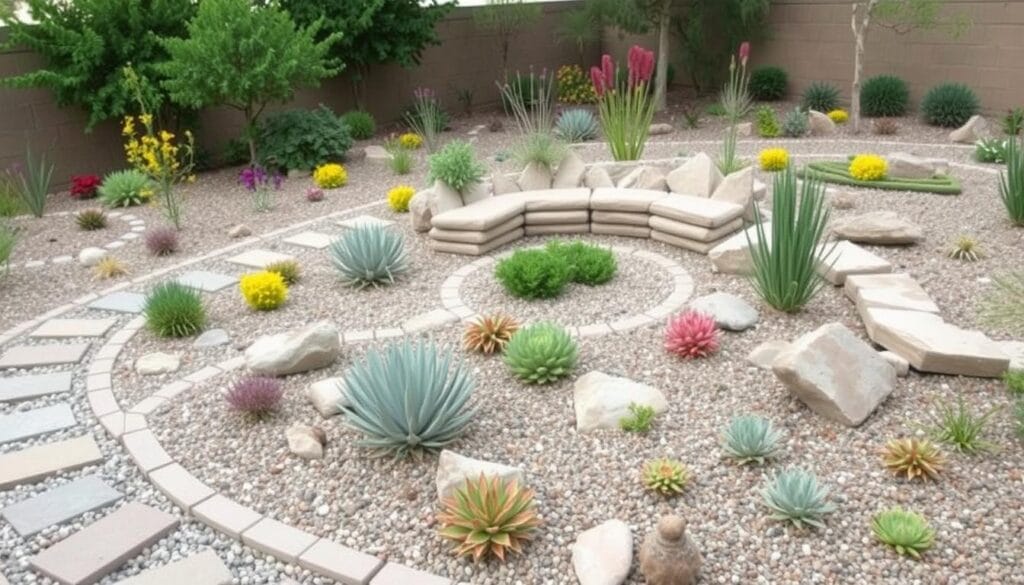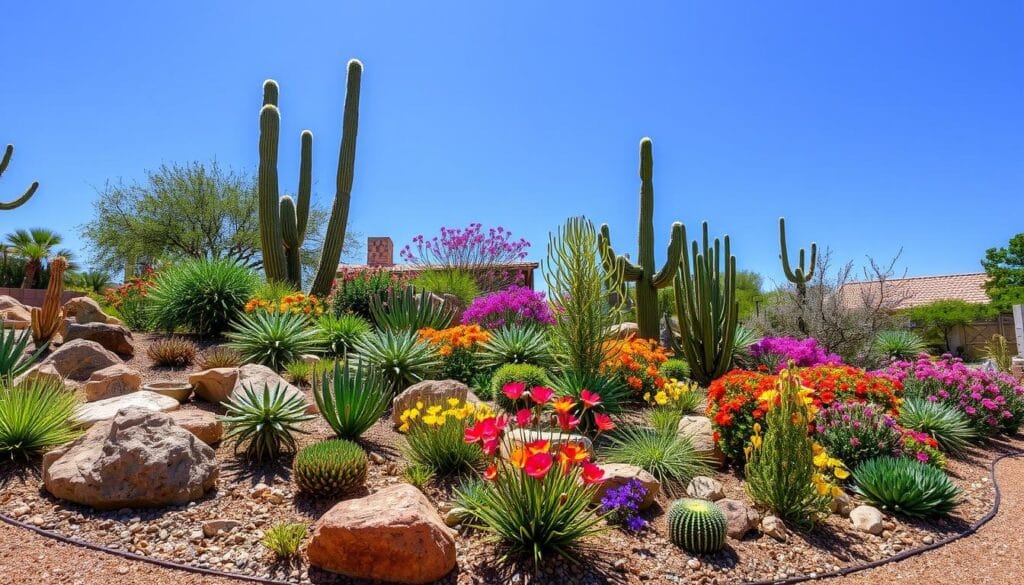Table of Contents
Did you know the average American household uses over 300 gallons of water daily? A lot of this water goes to watering lawns. By using xeriscape, you can save water and make your yard look great without much work. Learn how to turn your backyard into a beautiful, water-saving oasis.
This guide will show you how to pick drought-resistant plants and use smart hardscaping. You’ll learn how to create a water-saving yard that fits your style. Discover the benefits of xeriscaping and get tips to make your outdoor space better.
Embracing Xeriscape: A Sustainable Approach to Landscaping
Adopting xeriscape can transform your outdoor areas. It’s a water-saving method that also cuts down on garden upkeep. This approach is great for saving water and making your garden easier to care for.
Understanding the Concept of Xeriscaping
Xeriscape comes from “xeros,” the Greek word for “dry.” It’s a landscaping method that uses drought-resistant plants and smart water use. By using xeriscape, you can make your garden beautiful and water-friendly, fitting well with your local climate.
Benefits of Xeriscaping: Water Conservation and Low Maintenance
There are many perks to xeriscape. Choosing plants that are native or fit your local climate can save a lot of water. which not only saves money but also helps the environment. Plus, xeriscape gardens need less care, like mowing and weeding, so you can enjoy your garden more.
In Texas and Colorado, xeriscape gardens are getting more popular. People want to save water and have easy-to-care-for gardens. Whether you’re in xeriscape texas or looking for xeriscape ideas colorado, xeriscaping can make your outdoor space beautiful and eco-friendly.

Xeriscape Ideas for Your Backyard Oasis
Creating a lush, low-water backyard oasis is possible with the right xeriscape ideas. Xeriscape gardening focuses on drought-tolerant plants and smart design. It turns your outdoor space into a sustainable, beautiful retreat.
Choosing the right plants is key in a xeriscape garden. Native and adaptive species that love dry conditions are essential. Think of vibrant succulents, tough grasses, and colorful desert flowers that need little water.
- Agave and yucca plants add architectural interest with their unique, sculptural forms.
- Drought-tolerant perennials like lavender, sage, and lantana provide pops of color and fragrance.
- Ornamental grasses, such as feather reed grass and blue fescue, sway gracefully in the breeze.
Hardscaping elements are also vital in a xeriscape backyard. Rock gardens, dry creek beds, and permeable pathways add interest and save water.
| Hardscaping Element | Benefit |
|---|---|
| Rock Gardens | Showcase drought-tolerant plants while adding texture and visual interest. |
| Gravel Beds | Provide a low-maintenance, water-wise alternative to traditional lawns. |
| Permeable Pathways | Allow water to percolate into the soil, reducing runoff and promoting groundwater recharge. |
By picking xeriscape-friendly plants and using smart hardscaping, you can make your backyard a beautiful, easy-to-care-for oasis. It shows off the beauty of water-wise landscaping.

Drought-Tolerant Plants for Xeriscape Gardens
Choosing the right plants is key for a xeriscape garden. These plants love dry weather and need little care. They add beauty and are easy to maintain. Discover native and adaptive plants, and the beauty of succulent gardens.
Native and Adaptive Plant Species
Native plants are perfect for xeriscape gardens. They need little water and care, but add color and texture. Think about using drought-tolerant grasses, perennials, and shrubs that fit your area.
- Agave: Bold, architectural succulents that add unique visual interest.
- Yucca: Versatile plants with sword-like leaves and stunning flower spikes.
- Lavender: Fragrant and drought-tolerant, perfect for low-water gardens.
Succulent Gardens: A Xeriscape Masterpiece
Succulents are the stars of xeriscape gardens. They store water well and need little water. Mix different succulents to create a stunning garden.
| Succulent Species | Characteristics | Ideal Conditions |
|---|---|---|
| Echeveria | Vibrant rosette-forming succulents | Full sun, well-draining soil |
| Sedum | Diverse array of low-growing, spreading succulents | Partial to full sun, tolerant of various soil types |
| Opuntia | Iconic prickly pear cacti, in various shapes and sizes | Full sun, fast-draining soil |

Hardscaping Elements for Water-Wise Landscapes
Creating a xeriscape garden means combining soft and hard landscaping. Drought-tolerant plants are key, but hardscaping features can elevate your design.
Rock Gardens and Gravel Beds
Rock gardens and gravel beds are great for xeriscapes. They look good and save water. Rock gardens highlight sun-loving plants, while gravel beds cut down on weeds and runoff.
Permeable Pathways and Patios
Using permeable materials for paths and patios is smart. They let water soak into the soil, reducing runoff and the need for lots of water. This helps your xeriscape garden stay healthy without wasting water.
| Hardscaping Element | Benefits |
|---|---|
| Rock Gardens | Showcase drought-tolerant plants Require minimal watering Add visual interest and texture |
| Gravel Beds | Reduce weed growth Improve soil drainage and aeration Provide a low-maintenance surface |
| Permeable Pathways | Enhance water infiltration Minimize runoff and pooling Offer a natural, textured aesthetic |
Adding these hardscaping elements to your xeriscape ideas makes your garden beautiful and water-friendly. It follows the xeriscape landscaping principles well.
Irrigation Strategies for Xeriscape Gardens
Efficient irrigation is key to a successful xeriscape garden. By using smart irrigation methods, you can save water and create a beautiful, lasting landscape. Let’s look at two important strategies: drip irrigation systems and water harvesting.
Drip Irrigation Systems
Drip irrigation systems are a big help for xeriscape gardeners. They deliver water right to the roots, saving water and reducing weeds and diseases. By planning your drip irrigation well, you make sure every drop counts, keeping your garden healthy.
Rain Harvesting and Greywater Reuse
Water harvesting is also vital for a xeriscape garden. Collecting rainwater and using greywater from sinks and showers saves a lot of water. These methods help your garden stay green even when it’s dry.
Using drip irrigation and water harvesting together makes your xeriscape garden water-smart and beautiful. Try these techniques to make your xeriscape oasis thrive.
Maintenance and Care for Xeriscape Landscapes
Maintaining a xeriscape landscape is different from traditional gardening. To keep your space looking great, focus on a few key areas. These include making seasonal changes, pruning plants, using mulch, and controlling weeds.
Seasonal Adjustments and Pruning
Change your care routine with the seasons. In spring, cut back dead or too-long plants to help them grow. In summer, adjust your watering to meet the plants’ needs. In autumn, trim back plants and get ready for winter.
Mulching and Weed Control
Using a lot of mulch helps keep soil moist and stops weeds. Pick organic mulches like wood chips or bark. They break down and feed your plants. Regularly pull out weeds by hand or with a hoe to keep your plants healthy.
| Xeriscape Maintenance Task | Frequency |
|---|---|
| Seasonal Adjustments | Quarterly |
| Pruning | Annually or as needed |
| Mulching | Annually or as needed |
| Weed Control | Monthly or as needed |
By keeping up with these tasks, your xeriscape will stay healthy and beautiful. This will make your xeriscape ideas and xeriscape maintenance efforts worthwhile.
“Proper maintenance is the key to a thriving xeriscape landscape. With a little effort, you can enjoy the benefits of water-wise gardening for years to come.”
Conclusion: Embracing a Water-Wise Future
Xeriscape ideas are a smart way to save water in your garden. They use plants that don’t need much water and smart irrigation. This makes your garden beautiful and easy to care for.
Choosing xeriscape means you care about saving water and keeping your garden looking great. It’s perfect for making your outdoor space beautiful and eco-friendly. This article has given you great ideas to start or improve your xeriscape garden.
Starting your xeriscape journey is more than just picking plants. It’s about caring for the planet and using resources wisely. By going xeriscape, you help protect our water for the future. You’re making a difference, one garden at a time.
FAQ
What is xeriscaping, and how does it differ from traditional landscaping?
Xeriscaping focuses on saving water and gardening in a sustainable way. It uses plants that don’t need much water and efficient irrigation systems. It also cuts down on the use of water-heavy grass.
What are the benefits of a xeriscape landscape?
Xeriscaping saves water, needs less upkeep, and looks great. It fits well with the local weather. It can also lower your water bills and save you time and effort.
What types of plants are best suited for a xeriscape garden?
Plants that love dry conditions work best in xeriscapes. Think succulents, cacti, and native plants. These plants need little water and thrive in the local climate.
How can I incorporate hardscaping elements into my xeriscape design?
Hardscaping is key in xeriscapes. Rock gardens, gravel, and paths that let water through are great. They save water and add beauty and texture to your yard.
What irrigation strategies are best for a xeriscape garden?
Good irrigation is essential for xeriscapes. Use drip systems and collect rainwater. These methods cut down water use and keep your plants healthy.
How do I maintain a xeriscape landscape?
Caring for a xeriscape is different from regular landscaping. Adjust for the seasons, prune wisely, and use mulch. Also, fight weeds to keep your space looking good for years.

